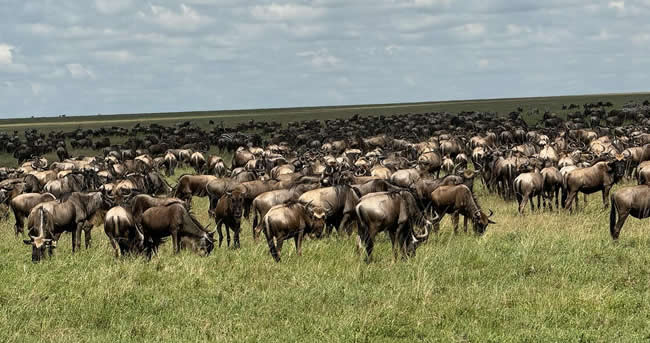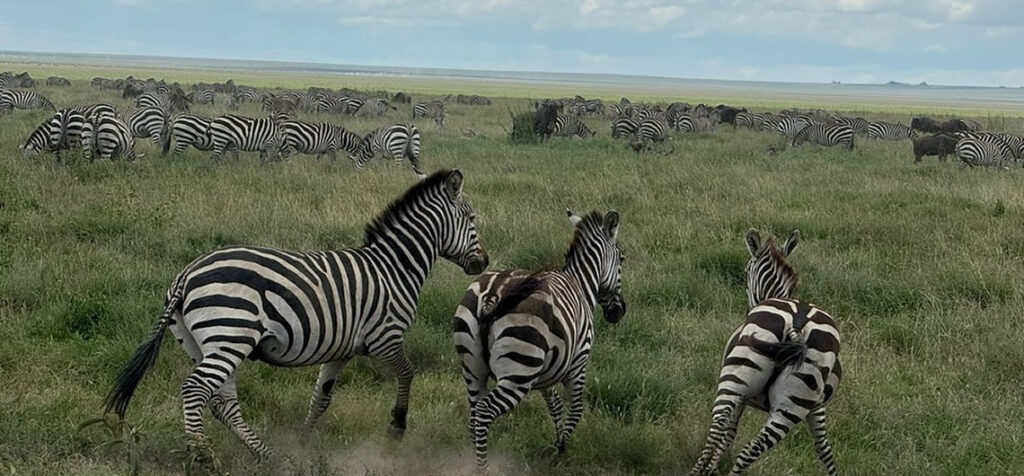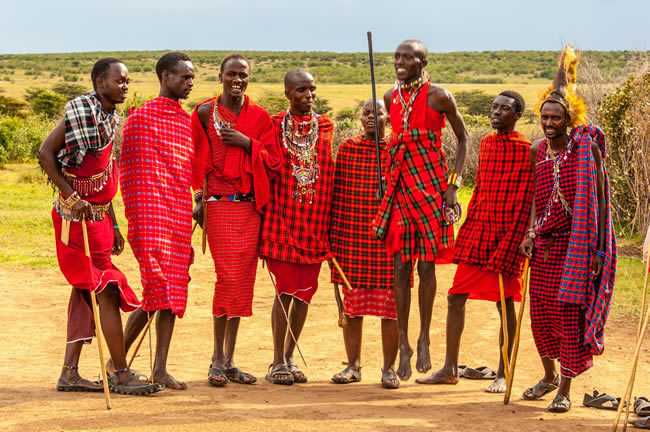Tanzania’s Serengeti National Park showcases the earth’s raw, wild beauty. This huge area of wildness, which spans 14,750 square kilometers, is well-known for its magnificent surroundings, unique species, and the unforgettable spectacle of the Great Migration. Serengeti National Park, established in 1951, has become a symbol of wildlife protection and a critical habitat for some of the world’s most iconic species. The park’s name, taken from the Maasai word “Siringet,” meaning “endless plains,” properly captures the immense horizons and remarkable power that visitors find when entering this exceptional sanctuary.
The Great Migration, widely regarded as one of the most magnificent natural spectacles in the world, is one of Serengeti National Park’s most striking characteristics. Every year, almost two million wildebeest, zebras, and gazelles make the dangerous trek across the Serengeti to the neighboring Maasai Mara in Kenya. This massive migration, fueled by the primitive need for fresh grazing space and water, attracts predators like lions, cheetahs, and crocodiles, resulting in an active and spectacular show of life and death. The sheer volume and raw intensity of the Great Migration attract wildlife supporters, photographers, and filmmakers from all over the world, eager to witness this incredible occurrence.

Beyond the Great Migration, the Serengeti National Park is home to a great variety of wildlife. The park has one of the world’s largest concentrations of huge predators, including the “Big Five”: lions, leopards, elephants, rhinoceroses, and Cape buffalo. In addition, the Serengeti is home to over 500 bird species, making it a birdwatcher’s dream. The park’s diverse ecosystems, which range from savannahs and woodlands to riverine forests and wetlands, provide habitat for a wide range of flora and fauna species. This vast biodiversity not only emphasizes the Serengeti’s biological importance but also provides limitless chances for scientific research and ecological studies.
The human history associated with Serengeti National Park is also fascinating. The park is part of the wider Serengeti-Mara environment, which has been inhabited by indigenous peoples like the Maasai for centuries. The Maasai, with their particular red costumes and deeply established traditions, have coexisted with wildlife, adapting their pastoralist existence to the rhythms of the landscape. The Maasai cultural heritage, as well as the archaeological sites distributed across the park, offer insight into the region’s past human history. These historical and cultural components deepen the natural glory of the Serengeti, improving the visiting experience.
Serengeti National Park faced major obstacles in recent years, including poaching, human-wildlife conflict, tourism pressures, and climate change. However, ongoing preservation initiatives led by the Tanzanian government and international groups seek to safeguard and preserve this ecological place. Anti-poaching patrols, community-based conservation projects, and sustainable tourism practices are critical to ensuring that the Serengeti environment continues healthy and vibrant for future generations. Serengeti National Park’s continuing attractiveness stems not only from its incredible surroundings and species but also from its resilience and community efforts to preserve its future.
Activities to do in Serengeti National Park in Tanzania.
Game Drives.

Game drives are the most popular activity at Serengeti National Park. Visitors take guided trips in 4×4 cars into the wide savannah in search of the Big Five (lion, leopard, rhinoceros, elephant, and Cape buffalo), as well as several other species like cheetahs, giraffes and zebras.
The best periods for game drives are in the early morning and late afternoon when animals are most active. These drives provide an opportunity to see the park’s amazing biodiversity and incredible scenery, ranging from wide plains to acacia woodlands.
Witnessing Great Migration.

Witnessing the Great Migration is an essential attraction during any Serengeti safari. Over two million wildebeest, zebras, and gazelles migrate in a continuous cycle in search of more wealthy pastures.
The migration usually runs from June to October, crossing the Mara River, which is filled with crocodiles. The view of massive animals rushing across the plains and facing the dangers of the river is one of the world’s most amazing natural occurrences.
Hot Air Balloon Safaris.

Hot air balloon safaris provide a magnificent viewpoint of the Serengeti before dawn. As you float silently above the terrain, you can see the wildlife below in their natural habitats and capture a peaceful view of the sunrise over the plains.
This calm encounter continues with a classic champagne morning meal in the bush, making it a luxurious and unforgettable adventure.
Guided Walking Safaris.
Walking safaris offer a private and engaging approach to experience the Serengeti. Visitors may walk through the park’s ecosystems with armed rangers and naturalists, learning about the flora and fauna firsthand.
This practice fosters a stronger relationship with nature by tracking animal footprints, observing smaller species that are typically overlooked on game drives, and learning about the complexities of the Serengeti’s habitat.
Cultural Visits to Maasai Villages.

Interacting with the local Maasai people adds a cultural layer to your Serengeti experience. Tourists can explore traditional Maasai villages and learn about their cultures, everyday lives, and traditional crafts.
These visits frequently feature traditional dance and song performances, as well as the opportunity to purchase handmade jewelry and artifacts. Engaging with the Maasai allows for a better understanding of the park’s natural history as well as its people’s heritage.
Bird Watching.
The Serengeti National Park is a birder’s paradise, with over 500 bird species. The park provides excellent birdwatching possibilities, including the distinctive secretary bird and kori bustard, as well as the brilliant lilac-breasted roller and many raptors.
Whether on a game drive, a walking safari, or simply meandering around the lodges, tourists can enjoy viewing and identifying a wide variety of birds that bring dynamic life to the Serengeti scenery.
Photography Tours.
The Serengeti’s gorgeous landscapes and abundant species make photography tours extremely popular. Professional guides, many of whom are also excellent photographers, assist guests in capturing the best photos of animals, landscapes, and dramatic situations.
These trips accommodate photographers of all skill levels, providing suggestions and placement to guarantee that everyone departs with amazing photographs from their safari experience.
Night Game Drives.
Night game drives provide a distinctive safari experience by displaying the Serengeti’s nocturnal side. Guides use spotlights to assist guests in identifying elusive evening wildlife like leopards, hyenas, and aardvarks. The noises of the night, from distant lion roars to nocturnal bird songs, create a troubling yet adventurous mood while highlighting the park’s complex and active environment after dark.
Where to stay in Serengeti National Park?
Whether you choose luxurious lodges or rustic campsites, being in the Serengeti provides a full-body experience. Many resorts offer beautiful vistas, sometimes of waterholes or migration paths. Camping, particularly in authorized locations, provides a more adventurous experience, with the sounds of the forest surrounding you at night. Both alternatives allow tourists to optimize their stay in the park, enjoying sunrise and sunset over the plains and the starry African night sky.
A visit to Serengeti National Park provides an assortment of remarkable experiences, ranging from the amazing spectacle of the Great Migration to close interactions on walking safaris and cultural trips to Maasai settlements. Whether you’re soaring above the plains in a hot air balloon or taking the perfect snapshot on a guided tour, each activity immerses you in the vibrant mosaic of life and nature that distinguishes this unique region.
